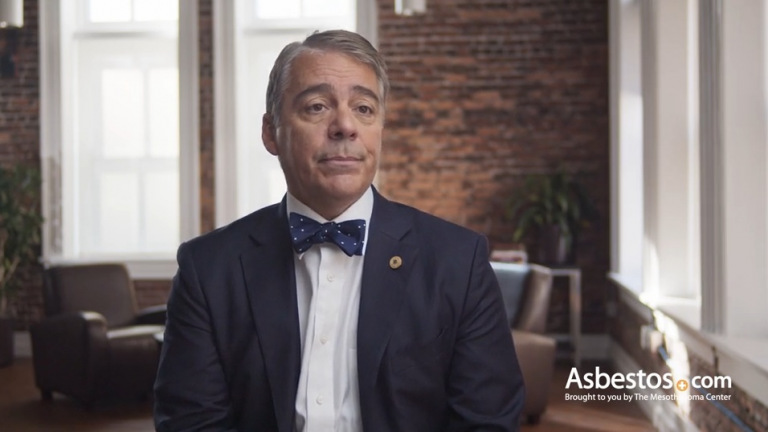Jayda was most likely exposed as a child through her father, who worked with asbestos products. This kind of asbestos exposure, when an asbestos worker unknowingly brings asbestos home on their clothing and work gear, is called secondary exposure. Jayda has four siblings, and she’s concerned about their potential prior exposure and what the future may hold.
Secondary Asbestos Exposure & Mesothelioma
Secondary asbestos exposure occurs when people who work with asbestos products carry the fibers home on their clothes, hair or skin. Like primary exposure, secondhand exposure can cause mesothelioma and other serious diseases. These illnesses have a latency period of decades before symptoms appear.
What Is Secondary Asbestos Exposure?
Secondary asbestos exposure occurs when a worker with asbestos materials indirectly exposes another to the toxic mineral. Secondary exposure is also known as secondhand, domestic or household exposure.
- A Journal of Lung Health and Diseases study found 30% of mesothelioma cases in the U.S. are due to secondhand exposure.
- Most household asbestos exposures happen among women, according to the American Journal of Industrial Medicine.
- Washing clothes covered in asbestos fibers raises the risk of developing mesothelioma or other asbestos-related diseases.
Most secondary exposure occurs when workers bring home asbestos fibers on their work clothes, hair and bodies. Family members may be exposed to asbestos by washing work clothes or hugging their loved ones after work.
A study in the British Journal of Industrial Medicine showed how a shipyard machinist’s wife developed mesothelioma from washing her husband’s clothing. The husband told researchers his work clothes were often “covered with [asbestos] dust.”
Secondary exposure is as dangerous as primary exposure. It can cause diseases like mesothelioma, lung cancer and asbestosis. It’s less common today because many industries have phased out asbestos. Also, workplaces have tightened asbestos regulations.
How Does Secondary Asbestos Exposure Occur?
Secondary asbestos exposure happens when asbestos fibers on clothing, furniture, or a person’s body transfer to other people. Asbestos fibers have a rough texture ideal for sticking to clothing, hair and skin.
People who don’t work directly with asbestos-containing products but share workspaces with those who do also have a higher risk of secondary asbestos exposure. This includes sharing an office, a work vehicle or desk chairs, particularly if they’re upholstered. This type of exposure is also known as environmental asbestos exposure.
Close physical contact, such as hugs or a child sitting in their father’s lap, can expose loved ones to toxic fibers on a worker’s clothing, skin or hair. Handling or washing contaminated clothing at home is also a secondary asbestos exposure risk.
Peritoneal mesothelioma survivor Jayda K. said was most likely exposed to asbestos as a child through her father, who worked with asbestos products in the coal mining industry.
Asbestos Brought Home on Clothing
Workers unknowingly carry asbestos fibers on their clothing after a day’s work. A study in the International Journal of Environmental Research and Public Health shows workers with the highest risk of bringing asbestos home included asbestos product manufacturing workers, insulators, shipyard workers and asbestos miners. Family members can be exposed when laundering their contaminated clothes.
Dr. Marcelo DaSilva, a thoracic surgeon at Advent Health Orlando, says, “I can think of at least three or four patients in which I’ve operated on” who were highly exposed to asbestos by a family member.
Contaminated Personal Items
Shoes, work bags, and tools may also collect asbestos fibers. These items can easily transport asbestos into the home or office, creating a dangerous environment for household members and co-workers.
Another common way home exposure occurs is through furniture and fabrics like carpeting, upholstered headboards, couch fabrics and curtains. Fibers transported into the home quickly become embedded in these materials and can transfer to others or become airborne and inhaled.
Risk to Family Members
Spouses, children and other household members are often exposed when they come into contact with contaminated clothes or personal items. Even close physical interactions with a worker can result in exposure over time, significantly increasing health risks.

Learn about your diagnosis, top doctors and how to pay for treatment.
Get Your Free GuideWhat Are the Health Risks of Secondary Asbestos Exposure?
Secondary asbestos exposure can cause mesothelioma, lung cancer, pleural plaques and asbestosis. Secondary exposure risks are the same as primary exposure, including pleural plaques and pleural effusions.
In some circumstances, secondary exposures have approached occupational levels. This is more likely to happen when a worker is employed in a high-exposure industry. Examples include asbestos miners, insulators, shipyard workers and construction workers.
Extensive research has proven that secondary asbestos exposure causes serious health effects. About 90% of all cases of malignant mesothelioma stem from asbestos exposure.
The number of yearly deaths from malignant mesothelioma in women saw a 25% increase from 1999 to 2020. Some experts suggest this may result from increased secondhand exposure, though women have also entered more fields that could lead to primary exposures.
Mesothelioma and Lung Cancer
Secondary asbestos exposure can cause mesothelioma, an aggressive form of cancer affecting the lungs and abdomen. It can also lead to lung cancer, with the same severity as those exposed firsthand.
Asbestosis
Asbestosis is a chronic lung disease caused by inhaling asbestos fibers. Prolonged exposure—whether direct or secondary—leads to lung scarring and breathing difficulties.
Why Secondary Exposure Is Often Undiagnosed
Secondary exposure cases are frequently misdiagnosed or identified too late because people may not realize they’ve been exposed. This can delay treatment, worsening the prognosis for those affected by asbestos-related diseases.
How to Protect Yourself from Secondary Exposure
Protecting yourself and your family from secondary asbestos exposure is crucial, mainly if someone in the household works in high-risk environments like construction, shipyards, or manufacturing. Asbestos fibers can quickly be brought into the home on clothing, shoes, and personal items, posing a significant health risk to family members.
To minimize exposure, it’s essential to follow safety precautions. Workers should change out of contaminated clothing before leaving the job site. Wearing protective gear, such as respirators and disposable coveralls, can significantly reduce the risk of bringing fibers home. Additionally, washing work clothes separately from other household laundry is crucial to avoid cross-contamination.
- Change clothes before coming home: Prevent bringing asbestos into your living space by changing at the job site.
- Wear protective gear: Use masks, gloves, and other protective clothing when handling asbestos.
- Wash work clothes separately: Keep contaminated clothes away from family laundry to avoid spreading fibers.
- Isolate contaminated items: Store shoes, tools, and work bags in a designated area to prevent asbestos from entering personal spaces.
For more information on safety standards, consult the Occupational Safety and Health Administration (OSHA) and the Environmental Protection Agency (EPA). These organizations offer guidelines and regulations for minimizing asbestos exposure at work and at home.
Get Your Free Mesothelioma Guide

Find a Top Mesothelioma Doctor

Access Help Paying for Treatment

Legal Options for Secondary Asbestos Exposure
Juries in several states, including California and Washington, have a history of awarding compensation to people who filed secondary asbestos exposure lawsuits. New Jersey and North Dakota recently rejected secondary exposure claims altogether. An experienced asbestos lawyer can help you determine if you’re eligible for compensation, where to file and how to document your exposure.
Each secondary asbestos exposure case that successfully awards the plaintiff compensation sets precedents for future cases. For example, the California Supreme Court ruled in 2016 that companies are liable for secondary exposure after two landmark lawsuits.
- 2023: Henry Pete developed malignant mesothelioma after childhood exposure when his father came home from work covered in asbestos dust. He died before collecting his compensation and his son awaits the $10.3 million jury award.
- 2022: A jury awarded Craig and Deanne Warren $17.2 million. Deanne’s husband’s work with asbestos products caused her secondary exposure that led to mesothelioma.
- 2021: A South Carolina jury awarded Robert Weist, the surviving spouse of Kathy Weist, $32 million. Kathy developed mesothelioma from secondary exposure. Her husband, father and uncle worked with asbestos products.
- 2013: John Panza Jr.’s father worked with asbestos products for 30 years. John Jr. received a diagnosis of mesothelioma in 2012 at the age of 40 and received a verdict of $27.5 million.
- 2013: A Seattle King County Court jury awarded Phyllis Granville $1.1 million after developing mesothelioma. She came in contact with the dust laundering her husband’s contaminated work clothes.
People who develop symptoms of mesothelioma, especially those with difficult exposure cases, can benefit from connecting with national law firms with robust resources to help with research. As Registered Nurse and Patient Advocate Karen Selby states, “Just leave it in their hands … They’ll be able to figure it out.”
Common Questions About Secondary Asbestos Exposure
- What are other names for secondary asbestos?
-
There are several additional names for secondary asbestos exposure. These terms are often used interchangeably.
- Domestic exposure
- Familial exposure
- Household exposure
- Indirect exposure
- Paraoccupational exposure
- Secondhand exposure
- Take-home exposure
These terms describe exposures when someone is in contact with another person with primary asbestos exposure. Spouses and children typically experience secondary exposure.
- How much asbestos exposure is dangerous?
-
Any amount of exposure to asbestos is dangerous and can cause mesothelioma and other asbestos-related diseases. There is no safe level of exposure. However, a person’s risk level can increase depending on the frequency and concentration of asbestos contact. Long-term, repeated exposure can raise the risk of developing cancer like malignant mesothelioma.
- Can you sue for secondhand asbestos exposure?
-
Secondary asbestos exposure can cause mesothelioma among family members of people who work with asbestos. Asbestos liability varies from state to state.
Secondhand legal claims aren’t as straightforward as direct exposure claims. However, a mesothelioma lawyer can investigate the source of asbestos and help family members file a successful claim.





